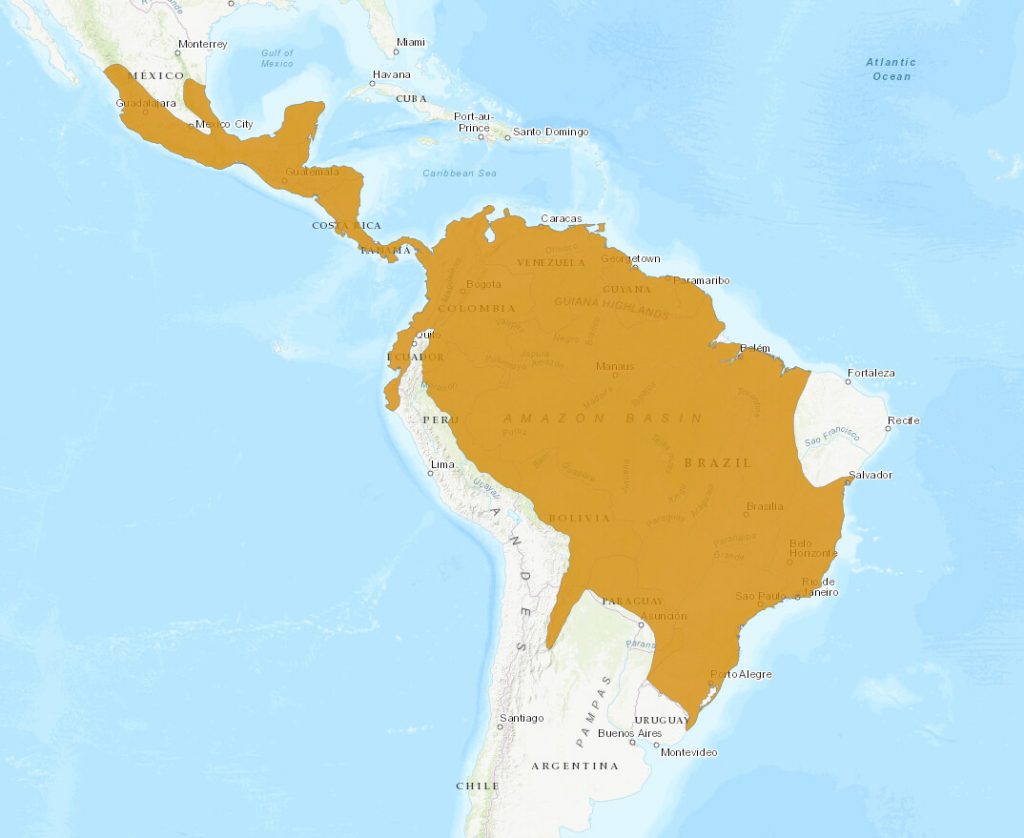Tayra
Eira barbara
©Adriano Gambarini
Taxonomy
Standard English Name
Tayra
Scientific Name
Eira barbara
Brazilian common name/s
Irara, papa-mel
Conservation status - IUCN
Physical Description
Is a small / medium sized animal – 90 to 120 cm in length and weighs 4 to 5 kg. The coat is short and thick, with dark brown to black colouration along the whole body and light brown or gray on the head and neck. The ears are short and rounded. It has a long body, slightly arched back, short legs and a long tail. Has great agility and can swim, run and climb trees very well.
Ecology and Habitat
It occurs from the tropical coastal region of Mexico to northern Argentina. It inhabits open areas such as those found in the Cerrado to dense forests, but is more commonly seen in areas of dense vegetation, where it rests in hollow trees. It is predominantly active in the daytime, with occasional night time activity. It is predominantly solitary, but can also be seen in pairs. It feeds mainly on rodents, but also poultry, honey and fruit.
Gestation lasts 67 to 70 days with 1 to 3 cubs.
An interesting fact: both the scientific name (Eira barbara), and Brazilian common name (Irara – origin from the Tupi-Guarani tribe), means honey eater.
Threats and Conservation
Hunting and forest destruction are the main threats to this species.
Online links
IUCN redlist (http://www.iucnredlist.org) presents a synthesis of current knowledge about distribution and conservation status.
References
Bezerra, B. M., Barnett, A. A., Souto, A., & Jones, G. (2009). Predation by the tayra on the common marmoset and the pale-throated three-toed sloth. Journal of Ethology, 27, 91-96.
Camargo, C. C., & Ferrari, S. F. (2007). Interactions between tayras (Eira barbara) and red-handed howlers (Alouatta belzebul) in eastern Amazonia. Primates, 48, 147-150.
Cuarón, A. D., Reid, F., & Helgen, K. (2008). Eira barbara. In: IUCN 2010. IUCN Red List of Threatened Species. Version 2010.2, <www.iucnredlist.org>, Downloaded on 06 July 2010.
Emmons, L. H., & Feer, F. (1997). Neotropical rainforest mammals: a field guide. Chicago: University of Chicago Press.
Goulart, F. V. B., Caceres, N. C., Graipel, M. E., Tortato, M. A., Ghizoni, I. R., & Oliveira-Santos, L. R. (2009). Habitat selection by large mammals in a southern Brazilian Atlantic Forest. Mammalian Biology, 74, 184-192.
Michalski, F., & Peres, C. A. (2005). Anthropogenic determinants of primate and carnivore local extinctions in a fragmented forest landscape of southern Amazonia. Biological Conservation, 124, 383-396.
Michalski, F., & Peres, C. A. (2007). Disturbance-mediated mammal persistence and abundance-area relationships in Amazonian forest fragments. Conservation Biology, 21, 1626–1640.
Michalski, F., Crawshaw, P. G., de Oliveira, T. G., & Fabian, M. E. (2006). Notes on home range and habitat use of three small carnivore species in a disturbed vegetation mosaic of southeastern Brazil. Mammalia, 70, 52-57.
Presley, S. J. (2000). Eira barbara. Mammalian Species, 636, 1-6.
